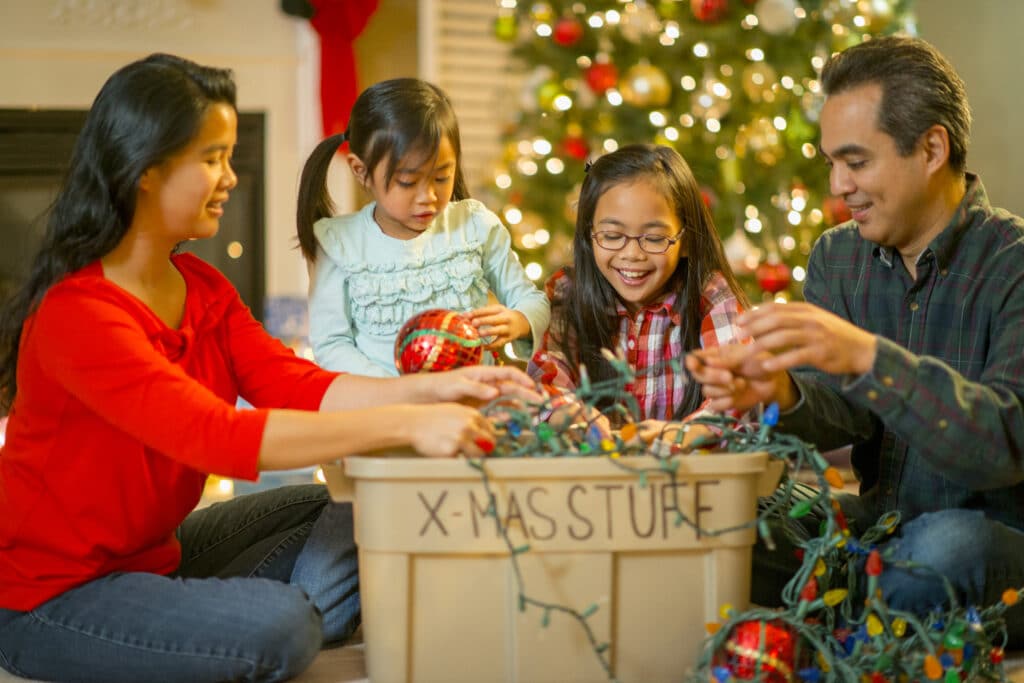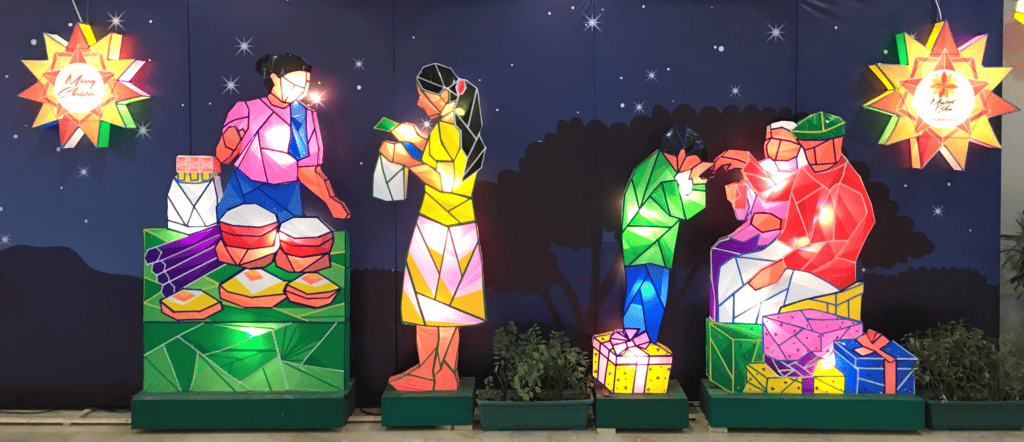
Ask any Filipino what their favorite holiday is, and they will likely say it’s Christmas. Filipinos love celebrating Christmas with special Christmas traditions in the Philippines. Christmas is one of the holidays everyone looks forward to the most in the Philippines.
For Filipinos who moved to other countries either to work or to immigrate, the holiday season always brings a sense of nostalgia. Although Filipinos may adapt easily to their host country’s way of celebrating holidays, some unique Filipino traditions can’t be duplicated elsewhere.
If you’re a Filipino living abroad, you’ll surely recognize and miss the things on this list created by our team here at Remitly.
Table of Contents
Starting the Christmas Period Early
The Philippines is famous for having the longest Christmas season in the world. People begin to celebrate Christmas as early as September.
Although you’re unlikely to hear people wishing each other a Merry Christmas in one of the country’s eight major languages so soon, many people do begin decorating with bright lights and Christmas lanterns as soon as the weather cools.
The fun of the holiday season continues throughout the fall. In December, Christmas cheer fills the air nearly everywhere you go, and formal celebrations are throughout the country. The festive season continues through the first week of January, with Epiphany on January 6th, and usually ends on the 9th.
Going to Simbang Gabi with Your Family
Simbang Gabi is the Philippines’ way of celebrating Advent. The tradition had its roots when Spain colonized the Philippines for over three centuries until its independence on June 12, 1898.
Simbang Gabi is a series of nine Masses starting as early as 4 a.m. on the days leading up to Christmas. The first mass takes place on December 16, and the last is on December 24, when they hold a midnight Mass to celebrate the birth of Jesus Christ.
If you’ve done Simbang Gabi, you undoubtedly remember your parents or grandparents waking you up early in the morning and the feeling of the cold morning air as you struggled to keep up while walking to church. They would have decorated the church with Christmas lights, and a nativity scene would always have been present.
After the Mass, plenty of street vendors are outside selling bibingka (rice cakes) and the Christmas favorite, Puto bumbong. This is a type of rice cake steamed in bamboo tubes. It’s usually purple and served with shredded coconut and brown sugar.
If the food after the Mass is not enough motivation to go to Simbang Gabi, Filipinos also believe that if you complete all nine of the Masses, a wish that you made during the first Mass will come true.
The early morning masses culminate in Misa de Gallo, or the rooster mass. It takes place at midnight after the Christmas Eve celebration and marks the official start of Christmas Day.
Decorating with a Paról
The paról is the Philippines’ version of the Christmas lantern. For Filipinos, it’s a visual representation of the Christmas spirit, a symbol of the star of Bethlehem.
You can see the paról hanging outside windows, in the streets, malls, and anywhere else you can think of. You know the holidays are near because streets will be lined with massive parols, treating people to a beautiful light show.
Traditional parols were made from a bamboo pole and papel de japòn (Japanese paper) and illuminated by candles. But as time passed, the materials evolved to include capiz shells and colorful plastic illuminated by electric twinkling lights.
Some families will decorate a paról instead of having a Christmas tree. Others decorate Christmas trees and display a paról.
Enjoying Christmas Carolers
Once the first Simbang Gabi finishes, Christmas carolers will be on their feet, going from house to house, singing Christmas songs to spread the season’s cheer.
Neighborhood children form groups and sing well-known songs like Jingle Bells, Silent Night, and Filipino Christmas songs such as Ang Pasko ay Sumapit and Christmas Bonus. Homemade instruments made from cola bottle tops or biscuit tins accompany them.
If you are happy with the Christmas carols, give them one or two pesos and wait for them to return the next night.
Carolers may also come in a more organized form, such as from your local church group or the school or office. They’ll usually send a letter beforehand informing you when they’ll visit your house. It’s expected for the host to serve snacks and give some money after listening to a medley of Christmas songs.
Celebrating “Noche Buena”
Noche Buena is Spanish for “good night.” In Spanish-speaking countries, as well as the Philippines, Noche Buena refers to Christmas Eve and the feast enjoyed that night. It’s the highlight of the Christmas celebration.
Other Latin countries celebrate Noche Buena, but in the Philippines, people eat a Noche Buena feast after hearing the night mass. Each Filipino household has its tradition of celebrating Noche Buena, and the food served is diverse.
Some of the amazing food that may have been a Christmas staple in your house include:
- Lechon (roast pig, chicken, etc.)
- Queso de bola (cheese)
- Bibingja (a rice cake made in a clay pot with coconut and sugar)
- Jamon (ham)
- Embutido (a type of meatloaf)
- Filipino-style fruit salad
- Lumpiang Shanghai (spring rolls)
Before or after Misa de Gallo on Noche Buena is also when children open Christmas presents coming from their ninongs and ninangs (godparents). Certainly, many Filipinos have memories of waking up at midnight to eat and open presents.
Christmas Parties Galore
Filipinos love to have a good time with their loved ones, and the holidays are one of the best excuses to throw parties. You’ll find parties everywhere during the Yuletide season in the Philippines.
These parties come in many permutations — office Christmas parties, church Christmas parties, Christmas parties for family members, neighborhood Christmas parties… You get the idea. Each event comes complete with gift-giving, songs, games, and, of course, tables laden with mouthwatering food.
People usually come home carrying gifts, leftovers, and many memories.
Exchanging Gifts
Christmas gifts are another common part of the holiday season. Children await the arrival of Santa Claus, the jolly figure in the red suit who puts presents beneath the Christmas tree during the early hours of Christmas morning.
Gift-giving among adults is also a big part of Christmas in the Philippines. Some Christmas celebrations include Manito-Manita, a type of Secret Santa where you draw names and secretly purchase a gift for the person you get.
It’s also common for godparents, known as “ninongs” and “ninangs”, to give their godchildren (called “inaanaks”) an aguinaldo, which is a spanish word that refers to either money or material items.
Setting Up Nativity Scenes
As in many Western countries, the nativity scene is a standard part of Christmas in the Philippines. Filipinos call them belen, after the Spanish name for Bethlehem.
Setting up a small belen in your home is a typical Filipino Christmas tradition. Some towns also host live nativity scenes with people playing the roles of the Virgin Mary, Joseph, and the Wise Men. There may even be live barn animals to make the scene more realistic.
Ringing in the New Year
New Year’s Eve, or Media Noche, is a big deal in the Philippines. People stay awake to greet each other during the first seconds of the New Year and enjoy food and fun together.
When midnight arrives, people often set off fireworks. This tradition stems from the idea that the loud noise will drive away evil spirits and usher in a prosperous new year.
Celebrating Three Kings Day and the Feast of the Black Nazarene
We’ve already said that part of what makes Christmas in the Philippines unique is how long the season lasts. Three Kings Day and the Feast of the Black Nazarene are the end of the Christmas season for many Filipinos.
Held on January 6 or the first Sunday in January, Three Kings Day remembers when the wise men traveled to visit Baby Jesus and present him with gifts. In honor of the day, people enjoy delicious food, exchange gifts, and visit with friends and family.
Observed on January 9 in Manila, the Feast of the Black Nazarene marks the day when an image of Jesus was moved from the Church of San Juan Bautista in Bagumbayan to the Saint John the Baptist Church. For the holiday, people gather in the street to attend the possession of the Black Nazarene. Then, they attend mass and say prayers.
Being with Friends and Family
Of this whole list, family and friends are what Filipinos miss the most while away from home.
Although Filipinos always miss their loved ones, Christmas, the season of togetherness and family, takes it to a new level. Filipinos try to fill this void by making new friends in their home countries and adapting to their home country’s way of celebrating the holidays.
They make phone or video calls if they have loved ones in the Philippines. Filipinos also send big Balikbayan boxes to their loved ones full of gifts, food, electronics, and more.
In addition to sending these boxes of love, gifts of money are also a way to say “I love you” and “I miss you.”
Frequently Asked Questions
American and Filipino cultures share many of the same holiday traditions, such as putting up decorations and sharing stories about Santa Claus, but there are some key differences. Americans tend to decorate real fir, pine, or spruce trees, but they’re not native to the Philippines, so Filipino families buy artifical trees to decorate instead. The Philippines also has a tradition called Simbang Gabi (Night Mass) where families gather for a series of 4am masses from December 16th to the 24th. After the nine masses are complete, a wish they make will come true.
In tagalog, “Merry Christmas” is “maligayang pasko.” The word “pasko” is the common word for “Christmas” in most Philippine languages. However, many Filipinos also speak English, so their Christmas greeting would simply be “Merry Christmas!”
The Philippines is a predominantly Catholic and Christian culture, so religious traditions take center stage. Filipino families wait all night on Christmas Eve until the day comes and then attend a dawn mass. Then, everyone gathers for Noche Buena, a midnight feast.
Some popular Filipino Christmas foods include lechon, which is a whole-roasted pig, puto bumbong (a purple rice), which is served after the dawn masses, hamon (ham), bibinka, a type of rice cake popular that time of the year, and a leche flan for dessert.
“Pinoy Pasko” refers to the unique Filipino traditions celebrated at Christmas. Parols (lanterns) hanging in a window or door are a sign of hope, and belen (nativity scenes) are elaborately displayed in homes and in public. Exchanging gifts is also common, typically either on Christmas day or during Noche Buena. Also, groups of children and adults go from house to house singing carols, often receiving treats or money in return.
The Christmas season in the Philippines lasts for the “ber months” of September through December, and Christmas decorations usually go up in September or October.
